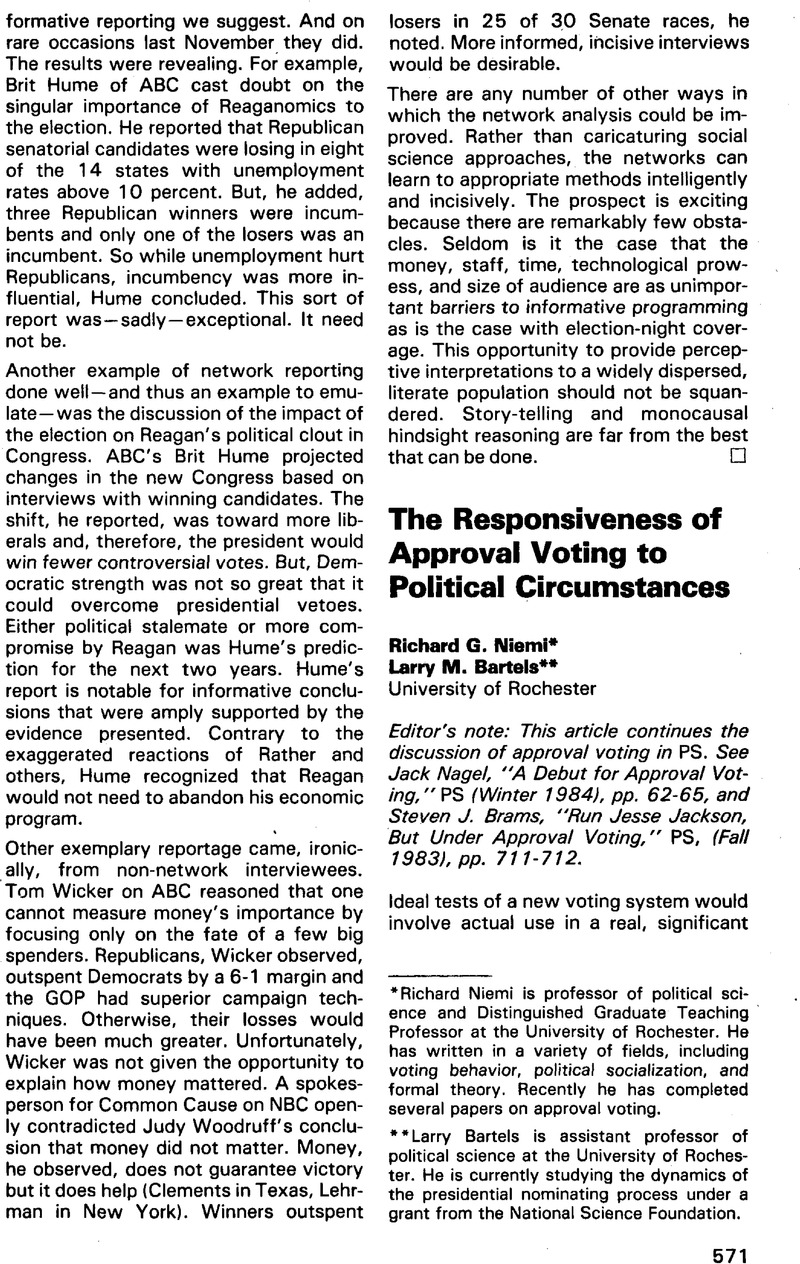Article contents
The Responsiveness of Approval Voting to Political Circumstances
Published online by Cambridge University Press: 25 November 2022
Abstract

- Type
- Other
- Information
- Copyright
- Copyright © The American Political Science Association 1984
References
1 Nagel, Jack, “A Debut for Approval Voting,” PS 17 (1984), 62–65.CrossRefGoogle Scholar
2 Approval voting is a voting system for multicandidate elections in which a voter may vote for as many candidates as he or she wishes. The primary source for theoretical results is Brams, Steven J. and Fishburn, Peter C., Approval Voting (Boston: Birkhauser, 1983).Google Scholar Empirical studies include DeMaio, Gerald, Muzzio, Douglas, and Sharrard, George, “Approval Voting: Some Recent Empirical Evidence,” American Politics Quarterly 11 (1983), 365–374 CrossRefGoogle Scholar (“candidates you would consider acceptable and have voted for”), DeMaio, Gerald and Muzzio, Douglas, “The 1980 Elections and Approval Voting,” Presidential Studies Quarterly 11 (1981), 364–373 Google Scholar (“candidates you would accept as the party's candidate for president”), Brams, Steven J. and Sharrard, George, “Analysis of Pilot Study of Preference Rankings and Approval Voting,” unpublished paper, New York University, 1979 Google Scholar (“persons you would consider voting for”), Kellet, John and Mott, Kenneth, “Presidential Primaries: Measuring Popular Choice,” Polity 11 (1977), 528–533 CrossRefGoogle Scholar (“candidates whose nomination you could support”), Bramš and Fishburn (pp. 11, 159, “candidates found acceptable”), Joslyn, Richard, “The Impact of Decision Rules in Multi-Candidate Campaigns: The Case of the 1972 Democratic Presidential Nomination,” Public Choice 37 (1976), 425–434 Google Scholar (thermometer scores), and Kiewiet, D. Roderick, “Approval Voting: The Case of the 1968 Election,” Polity 12 (1979), 170–181 CrossRefGoogle Scholar (thermometer scores). Nagel, “A Debut for Approval Voting,” discusses a case in which approval voting was actually used in a nonbinding presidential survey among party leaders in Pennsylvania.
3 Perhaps the biggest potential problem is that students will not take the task seriously. There was little indication of that here (e.g., no one voted for Mickey Mouse or Superman) except for Republicans “voting” in a Democratic primary. This was handled by eliminating Republicans, as described below.
4 Due to vacation schedules, the questionnaire had to be given just after Glenn and McGovern dropped out following Super Tuesday. We asked students to include Glenn and McGovern in their preferences anyway. This appeared not to create any problems, though there probably would have been more votes for them had we polled earlier.
5 Bartels, Larry M., “Expectations and Preferences in Nominating Campaigns,” presented at the annual meeting of the Midwest Political Science Association, Chicago, 1984.Google Scholar
6 For example, of 46 respondents who most preferred Hart, 19 (41 percent) voted for Mondale or Glenn under plurality voting in scenario three, where Hart's chance of winning was experimentally deflated.
7 Of course, support for a second candidate may vary as one's preferred candidate becomes more or less likely to win, so less variability under approval voting is not a logical necessity.
8 Niemi, Richard G., “The Problem of Strategic Behavior under Approval Voting,” American Political Science Review, forthcoming.Google Scholar
9 More individuals voted for both Hart and Mondale than voted for only one. Whether this was due to relative indifference between the two or to an absence of analysis, we cannot be sure.
10 Indeed, it is by no means clear what voters want from a voting procedure in the first place. In our study, 44 percent of the students had a “favorable” reaction to approval voting. “Favorable” reactions were more common among those who cast identical approval votes under all three scenarios (52 percent favorable) than among those whose approval votes varied with political circumstances (30 percent favorable). There were no clear differences in reactions to approval voting between Hart and Mondale supporters, or between voters who voted sincerely in all three plurality votes and those who did not.
- 11
- Cited by




